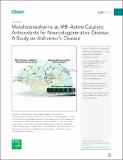| dc.contributor.author | Brewster, James T. | |
| dc.contributor.author | Thiabaud, Gregory D. | |
| dc.contributor.author | Harvey, Peter | |
| dc.contributor.author | Zafar, Hadiqa | |
| dc.contributor.author | Reuther, James F. | |
| dc.contributor.author | Dell’Acqua, Simone | |
| dc.contributor.author | Johnson, Rachel M. | |
| dc.contributor.author | Root, Harrison D. | |
| dc.contributor.author | Metola, Pedro | |
| dc.contributor.author | Jasanoff, Alan Pradip | |
| dc.contributor.author | Casella, Luigi | |
| dc.contributor.author | Sessler, Jonathan L. | |
| dc.date.accessioned | 2021-01-13T19:57:45Z | |
| dc.date.available | 2021-01-13T19:57:45Z | |
| dc.date.issued | 2020-03 | |
| dc.date.submitted | 2019-10 | |
| dc.identifier.issn | 2451-9294 | |
| dc.identifier.uri | https://hdl.handle.net/1721.1/129409 | |
| dc.description.abstract | The complex etiology of neurodegeneration continues to stifle efforts to develop effective therapeutics. New agents elucidating key pathways causing neurodegeneration might serve to increase our understanding and potentially lead to improved treatments. Here, we demonstrate that a water-soluble manganese(II) texaphyrin (MMn) is a suitable magnetic resonance imaging (MRI) contrast agent for detecting larger amyloid beta constructs. The imaging potential of MMn was inferred on the basis of in vitro studies and in vivo detection in Alzheimer's disease C. elegans models via MRI and ICP-MS. In vitro antioxidant- and cellular-based assays provide support for the notion that this porphyrin analog shows promise as a therapeutic agent able to mitigate the oxidative and nitrative toxic effects considered causal in neurodegeneration. The present report marks the first elaboration of an MRI-active metalloantioxidant that confers diagnostic and therapeutic benefit in Alzheimer's disease models without conjugation of a radioisotope, targeting moiety, or therapeutic payload. Neurodegenerative disease is correlated with aberrant oxidation and nitration of small-molecule neurotransmitters, proteins, DNA, and cellular membrane components. Cellular damage enhanced by these modifications propagates disease progression, leading to death. Effective tools that enable insight into the complex etiology of CNS diseases could allow researchers to find a cure. Part of this effort is focused on developing imaging modalities that can assist in understanding these diseases. Here, we demonstrate a new theranostic strategy that shows promise in addressing the oxidative and nitrative malfunctions considered causal in disease progression. The approach detailed in this report also allows the MRI of aggregated Aβ, which could lead to improvements in disease diagnosis. The present work is thus expected to set the stage for the mechanistic-based design of theranostics, useful in understanding and treating neurodegeneration. Sessler et al. have studied manganese(II) texaphyrin as a catalytic metalloantioxidant theranostic agent for the detection of Aβ aggregates. A series of in vitro and in vivo analyses allowed for the inference that metallotexaphyrins could be used for MRI-based detection of Aβ biomarkers. In vitro and cellular-based assays coupled with mechanistic analysis demonstrated an efficacious protective effect against oxidative and nitrative damage. The present results could thus guide future efforts in developing new theranostic modalities for use in neurodegenerative disease. | en_US |
| dc.description.sponsorship | NIH (Grant UF1 NS107712) | en_US |
| dc.language.iso | en | |
| dc.publisher | Elsevier BV | en_US |
| dc.relation.isversionof | http://dx.doi.org/10.1016/j.chempr.2019.12.016 | en_US |
| dc.rights | Creative Commons Attribution 4.0 International license | en_US |
| dc.rights.uri | https://creativecommons.org/licenses/by/4.0/ | en_US |
| dc.source | Elsevier | en_US |
| dc.title | Metallotexaphyrins as MRI-Active Catalytic Antioxidants for Neurodegenerative Disease: A Study on Alzheimer’s Disease | en_US |
| dc.type | Article | en_US |
| dc.identifier.citation | Brewster, James T. et al. "Metallotexaphyrins as MRI-Active Catalytic Antioxidants for Neurodegenerative Disease: A Study on Alzheimer’s Disease." Chem 6, 3 (March 2020): P703-724 © 2019 The Author(s) | en_US |
| dc.contributor.department | Massachusetts Institute of Technology. Department of Biological Engineering | en_US |
| dc.relation.journal | Chem | en_US |
| dc.eprint.version | Final published version | en_US |
| dc.type.uri | http://purl.org/eprint/type/JournalArticle | en_US |
| eprint.status | http://purl.org/eprint/status/PeerReviewed | en_US |
| dc.date.updated | 2020-05-05T13:01:14Z | |
| dspace.date.submission | 2020-05-05T13:01:17Z | |
| mit.journal.volume | 6 | en_US |
| mit.journal.issue | 3 | en_US |
| mit.license | PUBLISHER_CC | |
| mit.metadata.status | Complete | |
